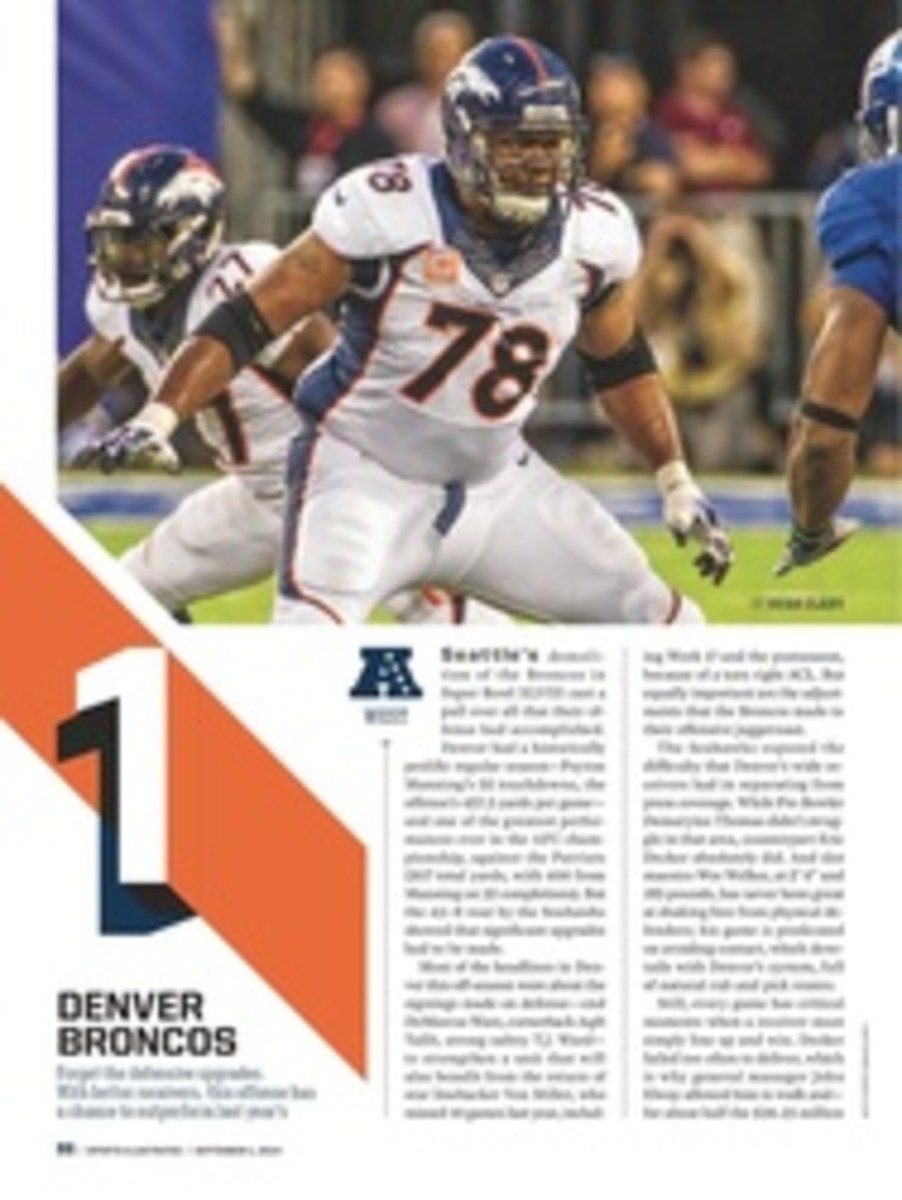
4 NEW YORK JETS
It was a favorite saying of John Madden's: If you have two quarterbacks, then you really have none. Regardless of who starts in Week 1 (and it looks like it will be Geno Smith), the Jets are destined for a QB change at some point in 2014. Last year a preseason injury to Mark Sanchez dropped the job into Smith's lap. Smith, in turn, got benched for Matt Simms midway through a disastrous Week 13 loss to the Dolphins, which was preceded by a string of poor outings. Smith likely would have sat the following weeks, too, if there had been an experienced veteran option.
And suddenly that's the case: Behind Smith is tried-and-tested free agent Michael Vick, who as an Eagle in 2010 had the best season of his career under current Jets offensive coordinator Marty Mornhinweg. If the 34-year-old Vick—who is making $3.4 million more than Smith this year—snags the starting job at some point, history suggests it's only a matter of time until he gets hurt.
Whichever QB starts, there's a good chance that his weaknesses will overshadow his strengths. If it's Vick, then vacillating accuracy and durability are concerns; with Smith, it's decision making and ball security. The main difference: Smith's shortcomings are not as certain to recur.
Unlike Vick, Smith, 23, is far from a finished product; he's still malleable as a player. In 2013 he displayed an admirable willingness to hang in a crowded pocket and make gutsy throws under duress—a vital trait. Unfortunately, many of those throws were directed into crowds created by coverage disguises. But that's not unusual for a rookie quarterback who rarely took snaps under center in college. The question is whether New York can be patient with his development, given that coach Rex Ryan and his staff are still not far from owner Woody Johnson's hot seat.
Winning with an inconsistent quarterback isn't impossible; it just requires a great supporting cast. And that's a luxury the Jets don't have, especially at wide receiver. If free-agent pickup Eric Decker ($15 million guaranteed) was remotely special, the Broncos would have used some of their considerable cap space to retain him. Assuming that 2012 second-round pick Stephen Hill remains a stiff and unaware route-runner, and that Jeremy Kerley is equipped strictly for the slot, then starting opposite Decker will be the inconsistent David Nelson.
If the Jets are in three-receiver personnel, they'll likely spread into plenty of two-by-two sets, allowing second-round rookie Jace Amaro, a 6'5" 265-pounder, to play the slot. Amaro is categorized as a tight end, but he was basically an inside receiver at Texas Tech. As soon as he expands his game to become a more traditional tight end (particularly as an in-line blocker), he'll fully supplant starter Jeff Cumberland.
So how will the Jets get by? Run-pass balance is crucial when an aerial attack lacks weapons, and New York signed free agent Chris Johnson from the Titans to help achieve that. But while Johnson has talked about regaining his 2,000-yard form, talking about it is pretty much all he's done since 2009. He has never been able to break tackles, and on the verge of turning 29, his declining speed means he's no longer lethal. Johnson's longest run in Tennessee last season went just 30 yards.
With Johnson unable to consistently create his own space, the Jets will find that their best runner is Chris Ivory, a tenacious fifth-year backup who brings a burst to the perimeter and whose second effort is potent enough to take would-be small gains to the house. Ivory, however, has never proved capable of carrying a heavy load week to week, and so in addition to Johnson, he'll share carries with Bilal Powell, a steady all-around back who has just a hair more speed than it appears.
For a team stocked with mediocre skill players, it would sure help to have an O-line that can dictate the terms of engagement. That's not the case. Left tackle D'Brickashaw Ferguson and center Nick Mangold, the stalwarts of this unit, are still quality starters, but they're coming off lackluster seasons by their standards. Playing like that again in 2014 won't be enough to hide the line's glaring weaknesses, such as the one at left guard, where the laterally limited Brian Winters floundered as a third-round rookie last year. At right guard Willie Colon is still a road grader, but he's not dynamic. And right tackle Breno Giacomini has to survive on little more than brute force and nastiness.
Ryan's Jets have survived with anemic offenses before, even reaching the 2009 and '10 AFC championship games. But this defense can't carry New York nearly that far. That responsibility will fall to the quarterback ... whomever he is.
2014 SCHEDULE
2013 Record: 8--8
WEEK 1
OAK [HOME]
GB [AWAY]
CHI MON [HOME]
DET [HOME]
SD [AWAY]
DEN [HOME]
NE THUR [AWAY]
BUF [HOME]
KC [AWAY]
PIT [HOME]
BYE
BUF [AWAY]
MIA MON [HOME]
MIN [AWAY]
TEN [AWAY]
NE [HOME]
MIA [AWAY]
WEEK 17
MAJOR CONCERN
Man-to-man cornerback
Coach Rex Ryan's designer blitzes—and his zone exchange concepts, which are pass rushes that look like blitzes but wind up bringing only four rushers—are predicated on creating confusion before the snap and early in the down. The sooner confusion sets in, the greater the likelihood that a quarterback will make a mistake. That's why the Jets, in their defensively driven deep-playoff-run years of 2009 and '10, only ranked near the middle of the league in sacks but still had the lowest completion percentage allowed. Many of Ryan's disguises and tactics hinge on having a lockdown man-to-man cornerback; that allows 10 other defenders to play zone across a smaller area. The problem: This season, instead of Darrelle Revis or Antonio Cromartie at corner, Ryan is stuck with Dee Milliner, who's coming off a dreadful rookie year and a preseason ankle injury, and Dimitri Patterson, who has never been asked to cover top-tier receivers. The Jets will struggle to be as complex and multiple as Ryan would like.
THE CASE FOR
Defensive tackle Muhammad Wilkerson
The long-armed fourth-year pro may well be the best NFL defensive lineman not named J.J. Watt. Wilkerson has an uncanny burst attacking downhill or fighting through congestion. His raw strength is staggering—ideal in a 3--4 Jets scheme that asks linemen to destroy whoever's across from them rather than worry about gap control. The Jets' thinking: If their linemen can be destructive, then the offense's play is more likely to alter, allowing inside 'backers to read and react more effectively. This philosophy prompted New York to draft another monstrous end, Sheldon Richardson, in round 1 last year. Like Wilkerson, Richardson can fill any spot up front, and the 2013 Defensive Rookie of the Year is in line to play every snap in '14. At nosetackle the Jets have another standout disrupter in Damon Harrison. He's not a shimmering athlete, but he moves well in traffic and plays with leverage that lets him explode off blocks. Plus, he gets the benefit of facing single blocking—because he's next to the 6'4", 315-pound Wilkerson.
PHOTO
RICH SCHULTZ/GETTY IMAGES
RB CHRIS IVORY
PHOTO
CARLOS M. SAAVEDRA FOR SPORTS ILLUSTRATED
NINTEEN PHOTOS

